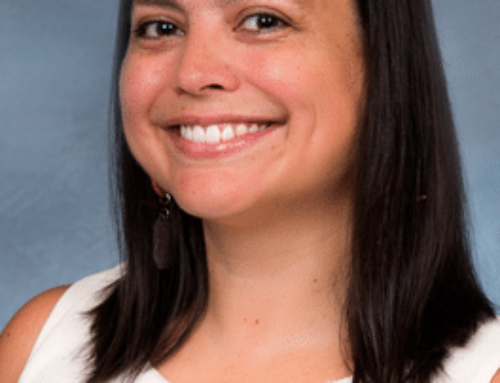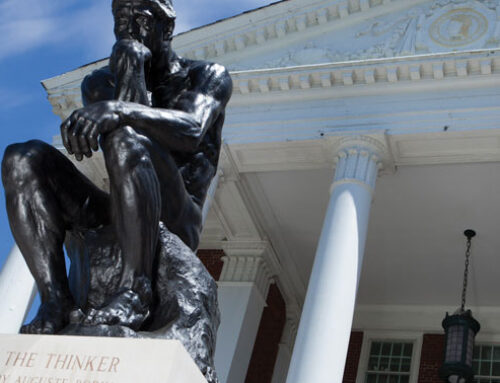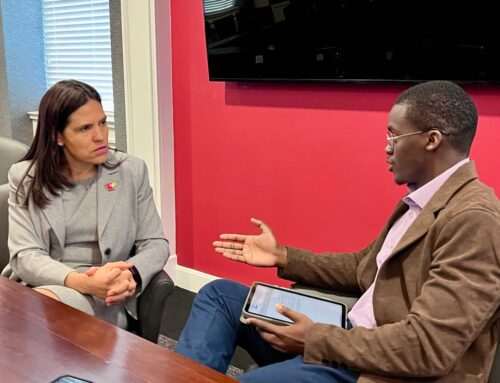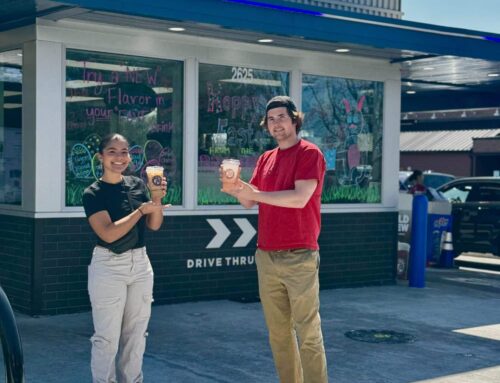
Bill Carner reminisces about his time at the University and his favorite photographs. Behind him in this picture is a photograph of a brightly lit store called Bill’s. The caption: ‘People always ask me what I’m going to do after I retire … ‘
By Simon Isham–
Bill Carner, longtime photo wrangler for the University of Louisville Photographic Archives will be saying his goodbyes to his coworkers on Dec. 25, the day he retires. But with that date more than a month away, Carner decided that he could not leave without curating one more gallery exhibition. The Photographic Archives presents “Bill Carner’s Swan Song: A Final Curatorial Exercise”, which will run until Jan. 25 in the Photographic Archives in the east wing of the basement of Ekstrom Library.
Before coming to Louisville, Carner studied art photography at the Rhode Island School of Design in the 1960s, did graduate work at Arizona State University, worked in a camera store and taught photography in Redding, Penn. He was encouraged to try Louisville by fellow photographer C.J. Pressma, who was present at the gallery opening on Nov. 8 and whose photographs are displayed in the gallery.
Carner arrived in Louisville on the day Elvis died, Aug.16, 1977, with the intention to enroll at the now-defunct Center for Photographic Studies. From here, he hoped to finish his master’s with Goddard College, having been offered a full-time teaching position in Pennsylvania upon the completion of his degree.
But Carner never took that offer. Instead, the then-curator of the University of Louisville Photographic Archives mentioned his impending retirement to Carner and advised him to apply for the position. Carner got the job, and has spent the last 34 years of his life serving the archives.
Carner was at the archives during its period of greatest growth, both in the size of the collection itself, and how seriously the program has been taken. When he started his job, the archives were located at the Reynolds Building, in Carner’s words, “a falling down, old, haunted place” that has since been converted into apartment lofts. During his career, he has been instrumental in securing a thriving print collection of over 2,000 photos, which were made to be seen as fine art. More than half of the photos in his new exhibit are from that collection.
Carner said that in his time spent in Louisville, he has become something of a local history expert, “as long as you don’t probe too deeply.” He specializes in the built environment and claims that much of his knowledge has come from the photographs in the archives.
He is pleased that the city’s photography culture goes beyond the archives. From photography gallery shows to photography discussion tables, Carner believes that there is great access to the photographic arts in Louisville. It was this community that helped him to find work with the Metro Chamber of Commerce, Greater Louisville Inc., taking photographs of buildings and authoring a book called “Louisville, Then and Now” in 2006. The book has since gone out of print.
That is why Carner has made plans with Butler Books, the publisher, to put together another book. The new book will also focus on built-environment photography, but will feature “a more full picture of Jefferson County, not just the Metro area.” He is also planning to create a gallery show for the 2013 Louisville Photo Biennial, as well as an exhibition in Pennsylvania of some work he did photographing abandoned buildings.

“I’m really knocked out by this photograph by Chloe Taylor, who was a New Albany high school student in 2009 and the winner of our Stern-Bramson Award, which is an award given to honor a photographer whose collection we have here. Her work was just head-and-shoulders above anything I’d ever seen before in the high school submissions, and her artist’s statement was better than any thing I’ve seen most artists.
Carner said that the thing he will miss most about his job at the archives is looking at the photographs, dealing with the images and interacting with his coworkers. He looks forward to spending the next 34 years working on his own projects in his digital darkroom. In March, he plans to take a three-month vacation to Paris, where he will take photos, eat well, take in a lot of art, “and give the French people something to laugh at when they hear me speak.”
Laura Hartford is a professor at Bellarmine University who received her Bachelor of Fine Arts from U of L. She worked at the archives as a darkroom technician during the summer of 1990, one of the few times that Carner was away. She told the Cardinal: “It’s a great show. The Photographic Archives are such an underrated resource that we have here in our community—it’s an unbelievable archives with a curator with a great sense of humor. And I love the explanations (of the photos), because you forget how much (the curators) know about photography, photographers and all the amazing people they’ve brought here to make work.”
The current head curator of the Photographic Archives, Elizabeth Reilly, said of Carner: “I’ve been here about a year and a half now, and without Bill, I don’t think I would ever be up-to-speed about the collection. I dread when he’s leaving, because he knows pretty much everything there is to know about the photograph collection, since he was here for 34 years building it, putting it together, processing it, scanning it. There’s really no one else who knows it like he does.
“(His new gallery) is wonderful. Rarely does anyone get to put together a show of their favorites. Usually there has to be some sort of theme, so this is really a rare opportunity. We’ll all be able to see some of the best of the best, by the guy who knows the collection the best … It’s a great testament to the archives in general, because we do have a really wide-ranging collection that encompasses so many themes and genres and types of photography. I think the theme, if I had to say, is the Photographic Archives.”
See Carner’s favorites from the archives
[email protected]
Photo: Tricia Stern/The Louisville Cardinal





